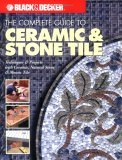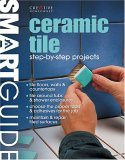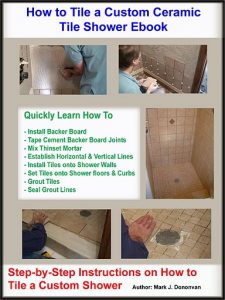Building a Custom Ceramic Tile Shower starts with a Shower Pan Membrane Liner and Cement Board
By Mark J. Donovan
|
|
Are you thinking about installing a custom ceramic tile shower?
If so, it is important to follow a very precise flow in the construction of it so that there is no possibility of it leaking. A ceramic tile shower is a beautiful addition to any bathroom remodel. However, if it is not installed properly it can cost you dearly in both time and money if it fails. |
If the shower springs a leak it can cause significant water damage to your home. Moreover, until you make the repairs to it the shower is out of commission.
Framing and Installing Rough Plumbing for Shower
The first two steps in any custom ceramic tile shower project is roughing in the plumbing and framing the shower area.
I highly suggest hiring a plumber to rough in the plumbing. Make sure they install an adjustable drain assembly in the base of the shower stall. In regards to the framing, I suggest using 2×6 wall studs for the side that contains the plumbing supply lines. The other wall surfaces can use 2x4s.
Framing Shower Walls
Make sure to add 2×6 blocking around the base of the shower walls for nailing the shower pan membrane liner to. Lastly, make sure to install an additional layer of ½ CDX plywood over the ¾ inch tongue and grove plywood subfloor, if not installing the shower on a concrete slab. You need to ensure you have a strong sub-floor to prevent any deflection in the ceramic tiled shower floor. If there is, the tiles and mortar shower pan will be susceptible to cracking, which could result in springing a leak.
After the initial framing of the shower stall area the next step in constructing a ceramic tile shower is to install a mortar shower pan.
Installing Mortar Shower PanThe mortar shower pan consists of pouring two layers of mortar into the shower floor area with a shower pan membrane liner sandwiched in between the two layers. It is critical that the mortar layers be sloped sufficiently enough towards the drain to allow proper drainage from the shower floor to the drain. In regards to sheathing the shower walls, it is important to use a cement backerboard type material. |

See the “Shower Pan Membrane Liner Installation Ebook” eBook for detailed instructions on how install a mortar shower pan properly. |
Sheathing Shower Walls with Durock Cement Backerboard
Durock is a common cement board that is highly resistant to water and is perfect for fastening ceramic tiles to. Durock cement board can be attached directly to the shower wall studs and ceiling joists using non-corrosive type screws. However, prior to attaching the Durock cement board to the wall studs, a moisture barrier should be stapled to the wall studs first. Polyethylene plastic or tar paper can be used for the moisture barrier material.
After fastening the Durock cement board to the shower walls, all of the seams should be taped and mudded using an alkaline resistant tape and thinset mortar.
Installing Ledger Board for Tiles to Rest On
You can then begin the process of tiling the shower. Start by attaching a ledger board(s) one to two tile rows up from the bottom of the shower walls. You want to make sure that you don’t sink nails or screws into the shower membrane liner too close to the bottom of the shower pan. Also, make sure the ledger board is level before fastening it into place around the base of the shower walls.
| With the ledger board(s) installed, you can then begin the task of actually tiling the shower walls.
Use thinset mortar to tile the shower walls, and eventually the floor. After each new row of tiles use a level to check that the row is level. Continue to work your way up the shower walls in this way. |
After the shower walls are all complete, remove the ledger boards and install the remaining one or two rows of tiles. Alternatively, you can tile the shower floor before installing the final row or two of wall tiles.
Grout Shower Walls and Floor
Allow the tiled shower walls and floor to set up for 24 to 48 hours. Then grout the shower walls and floor using a float, sponge, and a couple of buckets of clean cold water. Make sure to wipe off excess grout after immediately applying it to a section of wall or the floor. If you let it stay on for more than 30 minutes it may be difficult to remove.
After grouting the ceramic tile shower walls and floor, immediately go back and wipe the tiles down with a clean sponge and water. Repeat this process several times over the next few hours.
Lastly, use cheese cloth to polish the tiles to a shiny finish.
For information on installing a shower pan membrane liner for a ceramic tile shower, see the Shower Pan Membrane Liner Installation Ebook from HomeAdditionPlus.com. The Shower Pan Membrane Liner EBook will quickly teach you the step-by-step process for installing the shower pan membrane liner correctly. It includes instructions on framing the shower stall, pouring the pre-slope and shower base mortar, and installing the shower pan membrane liner.
See HomeAdditionPlus.com’s Ceramic Tile Calculator
See my “How to Tile a Custom Ceramic Tile Shower” Ebook to learn how to tile your own shower: For a detailed set of instructions on tiling a shower floor and walls, including pictures for every step in the process, see my “How to Tile Custom Ceramic Tile Shower Ebook”.
Related Information
- How to Buy the Right Tile Wet Saw
- Setting Bathroom Floor Tile
- How to Tile a Custom Ceramic Tile Shower Video
Additional Ceramic Tile Resources from Amazon.com
 |
 |
 |
Get Free Bathroom Remodeling Price Quotes with No Obligation!
Fill out our 3-5 minute quick and easy form, and receive a free price quote on a bathroom remodeling project from one of our pre-screened and licensed bathroom remodeling contractors. This process is free and there is no obligation to continue once you receive your bathroom addition price estimate.


